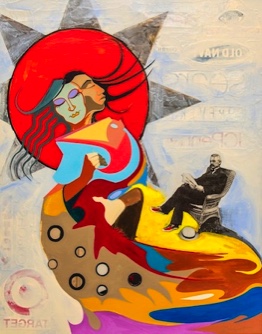Click the logo to go to the Lakota Emergence
homepage
Because she wants to entice her relatives in the underworld to come to this world, Anunk Ite carefully chooses the meat and prepares it deliciously. She expertly tans the moose, deer and bear hides and creates beautiful clothing. She wants to send only the best to her relatives. Also being a mother of five sons, Anunk Ite must have known that her relatives in the underworld would be hesitant to come to this world if they feared their children would be endangered in any way.
Keith BraveHeart offers us a new interpretation of the double-faced woman in his serene representation of her two faces. Instead of being horrendously ugly, her second face is supernaturally strange, and maybe even uncomfortably alluring. Reflecting on his decision, Keith says, “I do not think she was uncaring, or ugly in the way we normally would think about it. I think she loved her relatives, and was very compassionate. I did not want to paint her as an ugly woman.” His portrait of Anunk Ite is set against a red sun that frames her faces, and seven dark triangles around its perimeter evoke a sunburst design that “references back to the creation story and how Double-Face woman earned her ugly face by causing the Sun to look at her beauty instead of his wife, the Moon.” The seven triangles also foreshadow the number of Pte families that will eventually emerge onto this earth.
“I’m a contemporary artist,” Keith states, “and I want to interpret these traditional stories in modern terms. I want to use humor and irony in my paintings.” In his painting is James Walker, the person who wrote down the Lakota emergence narrative. Walker, seemingly indifferent to the importance of the narrative he recorded, is sitting in a wicker chair dressed in a suit but wearing a fancy pair of moccasins, symbolizing the split between his Western education and his interest in Lakota culture. In modern times, most Lakotas purchase their clothing from stores, so Keith included contemporary store logos in his painting. In a creative move to reach younger audiences, Keith attached seven small mirrors to the lower left portion of his canvas. Consequently, all of us, whether or not we are Lakota, become part of the piece and of the ongoing emergence narrative through seeing our reflections in these mirrors.
She dried the flesh and tanned the skins, and gathered much meat and many robes and soft tanned skins. She made clothes for a man and for a woman and decked them with colors. Then she made a pack of the clothes and choice bits of the meat.

